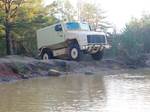New MIL antiballistics standard
New military specifications for unidirectional thermoplastic laminates used in antiballistics applications are circulating in draft form for comments and should be completed by year’s end.
New military specifications for unidirectional thermoplastic laminates used in antiballistics applications are circulating in draft form for comments and should be completed by year’s end. Materials suppliers assisted the Army Research Laboratory (Adelphi, Md.) in drafting the MIL specifications, which cover four classes of fiber used to reinforce in thermoplastic matrices: aramid, polypropylene, ultrahigh-molecular-weight polyethylene and glass.
Dr. Karl Chang, research associate at DuPont Protection Technologies (Wilmington, Del.), says the MIL specifications will not require armor manufacturers to change their practices, but rather, the intent is to provide those responsible for military procurement with a high degree of certainty that the product they buy today is the same as the product they bought last month.
The specifications include details of how to make and mold test panels, as well as criteria for passing the Fragment Simulating Projectile Ballistic 50 antiballistic performance standard. The FSPB50 protocol specifies the velocity at which 50 percent of the projectiles are expected to penetrate a panel while the remainder is stopped.
Dr. Chang points out that the new MIL specification should not be interpreted to mean the military is getting substandard laminates. What’s at issue is uniform application of requirements. “It’s a classic problem. If there is a requirement but no specification, that requirement is open to interpretation,” he explains. “There is no other way to interpret a specification than how it is written.”
Related Content
-
The potential for thermoplastic composite nacelles
Collins Aerospace draws on global team, decades of experience to demonstrate large, curved AFP and welded structures for the next generation of aircraft.
-
Co-molding SMC with braided glass fiber demonstrates truck bed potential
Prepreg co-molding compound by IDI Composites International and A&P Technology enables new geometries and levels of strength and resiliency for automotive, mobility.
-
Assembling the Multifunctional Fuselage Demonstrator: The final welds
Building the all-thermoplastic composite fuselage demonstrator comes to an end with continuous ultrasonic welding of the RH longitudinal fuselage joint and resistance welding for coupling of the fuselage frames across the upper and lower halves.


